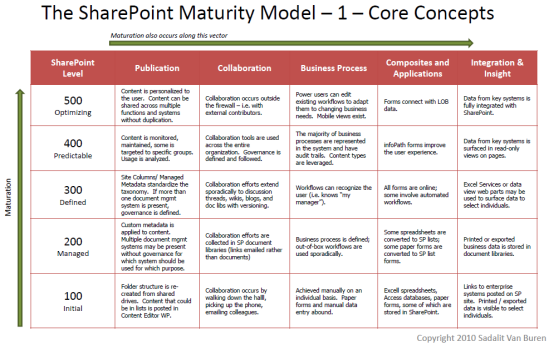The SharePoint Maturity Model, Version 1.0
 Guest Author: Sadie Van Buren
Guest Author: Sadie Van Buren
A Matter of Degree
As SharePoint gains in popularity and adoption worldwide, an increasing number of resources are available to help organizations understand and navigate the different aspects of this platform. What’s missing is a cohesive way to analyze and understand the system as a whole. Yet many experts have observed that, although SharePoint implementations vary from organization to organization, there is a typical progression of implementation, upward through each functional area and across the areas together. I created the SharePoint Maturity Model to apply a holistic view to a SharePoint implementation, and to bring standardization to the conversation around functionality, best practices, and improvement.
This model is intended to help you take a realistic look at your SharePoint implementation. Use it to determine where you are currently, and what level of SharePoint maturity you desire to achieve. You can then work with an expert (or experts) as needed to develop a roadmap that will get you there.
A note on the structure: For the sake of readability the competencies have been split across two pages, Core and Supporting. While Search and People & Communities are Core concepts to SharePoint, the way they are implemented does not fit into any particular progression – i.e. an organization might get all the way to Business Intelligence initiatives without making any adjustments to out-of-box Search and/or leveraging Profiles and MySites. In future versions of the Model, the arrangement of the competencies may change to allow for expansion.
I’m imagining that quite a few folks in the SharePoint community will have their own opinions about what it means to reach SharePoint Maturity, and I welcome comments that will help improve this model!
 Guest Author: Sadie Van Buren
Guest Author: Sadie Van Buren
A Matter of Degree
Sadie Van Buren is a Consulting Manager at Burntsand (a Gold-Certified Microsoft Partner and division of OpenText), and a Microsoft Certified Technology Specialist. Her main area of focus is in designing and leading SharePoint deployments, specifically from a usability and adoption perspective, and she blogs about SharePoint and technology at http://amatterofdegree.typepad.com/









Love it Sadie.
One note on it: Do you think maybe Insights and Integration should be seperated?
I understand where you got the information from and how it aligns with some of the marketing from Microsoft. The challenge I have is that often insights deals with significant BI aspects and often connecting to LOB systems (also noted in composites), or integrating them into SharePoint is really integration.
So for the sake of the model I think these two should be broken into seperate columns. There are lots of ways BI goes through phases and where integration goes through phases that while similar have different focuses and impacts. Not to mention each disipline is very deep.
If I think of a couple of my previous clients many had strong Integration (able to manage data in other systems from SharePoint etc) but poor BI/Insights (measurement overall in the org was not mature) as an example.
What are your thoughts?
Great stuff, Sadie! Will be studying this in depth over the next few days. Thanks!
Richard – thank you for your comment, that’s a great suggestion, and now that you point it out I agree, the two are different enough to be separate competencies. Would you be willing to work with me on identifying the maturity levels for each in a broken-out scenario? This is exactly the kind of feedback I was hoping for by posting this model here.
Jim Bob – thank you! Don’t hesitate to send constructive feedback if you have any!
I would love to!
If you are coming the SharePoint User Group next Wednesday that’s a good time for us to talk about coordinating – I am speaking on Interoperability and Integration etc.
Some of the ideas I have for this (depending on how open you are to it) would be to create a series of articles on the model, how it can be used, scenarios, and statistics/what happened when we used it with various clients (case studies). This could all easily live in the combined SPDevWiki, ITPro, EUSP, and SharePoint Business Community site – it might even spawn seperate models.
Example:
SharePoint Development Maturity Model
SharePoint IT Pro Maturity Model
SharePoint End User Maturity Model (Taking a more specified approach.)
SharePoint Business Maturity Model (Closer to what you sort of have right now perhaps?).
Lots of ways to approach enhancing it. :)
Great post Sadie i can follow our journey to Sharepoint land exactly as described in your models. Superb
Sadie,
I am a huge fan of maturity models. From my role in marketing, we are always trying to refine our buyer personas and to better target organizations ripe for our type of solution. The maturity models not only serve as a good market analysis tool, they also serve to help end-user organizations assess and prioritize their maturity roadmaps.
When working with Gartner maturity maps for various industries and technologies, it is often stated that the evolution of maturity from one stage to the next takes about two years. I am wondering if you or others readers here would say the same holds true for this maturity model.
Additionally, I wondering if people can comment on moves their own organization has made from one level of maturity to the next and what the drivers were for that migration. Curious to know if there are any common themes there.
Thanks again for sharing this model!
@Richard – Lots of great ideas from you there! I will see you on the 10th at the user group, let’s discuss in detail
@ Dave Coleman – thank you, glad to hear it!
@ Derek – there is a time component that could be represented here for sure, and I will think about this to see if there is any standard I can apply to the movement from one stage to the next. What I see commonly is that organizations approach the competencies in varying ways, some may be at level 100 for some competencies at the same time they’re at level 300, 400, even 500 for others. Sue Hanley suggested a spiderweb graph to represent this and I’m working up a template that will let users plug in their numbers and graph it easily.
I second your call for folks to comment on their own experience with moves between the stages, and what the drivers were. I’d be very interested. I know that in some cases, regulatory issues are the stick that drives greater maturity; what are some others?
I like the idea of the spider diagram that Sue suggested. I agree that it is realistic for businesses to reach new maturity levels for different competencies at varying times. Organizational, cultural, economic, technology, regulatory, and other influences may accelerate or slow maturities in competencies.
As a technology vendor, we certainly see technology choices aiding in the acceleration of maturity levels. That said, the driver for reaching the next maturity level is often not driven by technology, but rather economic, political, social, or other other priorities.
I like your idea of the diagram with self-scoring. This would allow people to identify where they current sit, where their greatest pains or opportunities are related to SharePoint maturities, and where the next opportunities for investment would be best served.
Great article, good first start. I’m sure everyone will have suggestions and comments, so let me add my two cents, since I see this as a valuable tool to measure clients against the model. I’ve used this at my current client to assess tactical v. strategic adoption and implementation. I have three observations and suggestions:
1. I tend to present and talk about SharePoint in what I call the six SharePoint verticals: Portals, Collaoration, Search, Business Intelligence, MSFT Product Integration (Project Server, Team Foundation Server) and Non-MSFT Product Integration (EMC/Documentum, etc.). I’d be interested in re-mapping the core concepts to that set of verticals.
2. I think it would be valuable to work through what steps/features/integration points/etc. would be required to move up the ladder, that is, how do I get from the 200 to 300 level? – what’s required to be in place to gget to the ultimate 500 level for integrating line of business data if I’m at the 300 leve.
3. I like cubes, since I can see the data in more than one perspective or dimension and rotating cubes is always cool. In this case, I’d consider the core concepts (verticals) as Dimension 1, Dimension 2 as the Supporting Concepts (and I’d add maybe two additional columns or consolidate, so that both training and the management of change (from a communications standpoint) with the third dimension being the vertical model path in getting from 10 to 200 to 300. etc.
Hey, just an idea, but something I’ll be examining as a modeling/implementation modeling tool.
Great job and kudos to Ms. Van Buren on this intriguing idea.
Ray Walters
For organizations who have not yet implemented SharePoint, or who are frustrated with efforts to make use of it:
I can envision a collaboration maturity model, (regardless of technologies or tools.)
In such a model (with scoring) – a collection of behavioral actions are described along with a subjective rating (on a continuum from “We would punish that” to “We wish everyone would do that!”) A cumulative scoring of such a model would predict the organization’s propensity to collaborate. If given discretely to different individuals (of various responsibility/authority,) individuals could be identified who are (or are not) aligned to the organizations collaboration objectives…
@Ray Walters – this is a long time in coming but thank you for your thoughtful comment! I like the idea of the Integration vectors and also of the cube – it does seem that this model is more dimensional than flat. I’ve made quite a few updates to the model since the first version and plan to re-publish soon; the new version does pull in the supporting / readiness concepts more.
@Dan Dunne – Paul Culmsee at Clever Workarounds has done a lot of thinking about a collaboration model – he has a three-part series on his blog that you can check out here (I’m starting with post #2 because it goes directly into the matrix).
http://www.cleverworkarounds.com/2011/01/19/the-facets-of-collaboration-part-2enter-the-matrix/